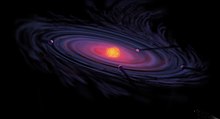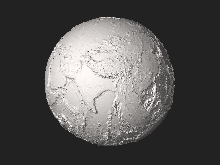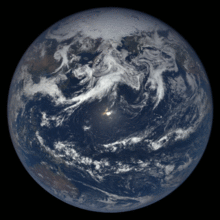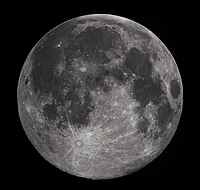ကမ္ဘာဂြိုဟ်
 "အပြာရောင်ပုလဲလုံး" အား ၁၉၇၂ ခု အပိုလို ၁၇ မှ ရိုက်ကူးခဲ့သည်။ | |||||||||||||||||
| ပတ်လမ်း ဂုဏ်အင်များ | |||||||||||||||||
|---|---|---|---|---|---|---|---|---|---|---|---|---|---|---|---|---|---|
| Epoch J2000 | |||||||||||||||||
| အဝေးဆုံးပတ်လမ်း | ၁၅၂,၁၀၀,၀၀၀ km (၉၄,၅၀၀,၀၀၀ mi) (1.01673 AU) | ||||||||||||||||
| အနီးဆုံးပတ်လမ်း | ၁၄၇,၀၉၅,၀၀၀ km (၉၁,၄၀၁,၀၀၀ mi) (0.9832687 AU) | ||||||||||||||||
ဆီမီး မေဂျာ ဝင်ရိုး | ၁၄၉,၅၉၈,၀၂၃ km (၉၂,၉၅၅,၉၀၂ mi) (1.000001018 AU) [၁] | ||||||||||||||||
| ပတ်လမ်း ဗဟိုကျမှု | 0.0167086[၁] | ||||||||||||||||
ပတ်လမ်း ကာလ | |||||||||||||||||
ပျမ်းမျှ ပတ်နှုန်း | |||||||||||||||||
ပျမ်းမျှ မူမမှန်မှု | 358.617° | ||||||||||||||||
| ပတ်လမ်း တိမ်းစောင်းမှု | |||||||||||||||||
Longitude of ascending node | −11.26064°[၃] to J2000 ecliptic | ||||||||||||||||
Argument of perihelion | 114.20783°[၃] | ||||||||||||||||
| ဂြိုဟ်ရံလများ |
| ||||||||||||||||
| ရုပ်ပိုင်းဆိုင်ရာ ဂုဏ်အင်များ | |||||||||||||||||
ပျမ်းမျှ အချင်းဝက် | ၆,၃၇၁.၀ km (၃,၉၅၈.၈ mi)[၅] | ||||||||||||||||
အီကွေတာ အချင်းဝက် | ၆,၃၇၈.၁ km (၃,၉၆၃.၂ mi)[၆][၇] | ||||||||||||||||
ဝင်ရိုးစွန်း အချင်းဝက် | ၆,၃၅၆.၈ km (၃,၉၄၉.၉ mi)[၈] | ||||||||||||||||
| ပြားချပ်မှု | 0.0033528[၉] 1/298.257222101 (ETRS89) | ||||||||||||||||
| စက်ဝန်းမျဉ်း | |||||||||||||||||
မျက်နှာပြင် ဧရိယာ | |||||||||||||||||
| ထုထည် | 1.08321×1012 km3 (2.59876×1011 cu mi)[၃] | ||||||||||||||||
| ဒြပ်ထု | 5.97237×1024 kg (1.31668×1025 lb) (3.0×10−6 M☉) | ||||||||||||||||
ပျမ်းမျှ သိပ်သည်းဆ | ၅.၅၁၄ g/cm3 (၀.၁၉၉၂ lb/cu in)[၃] | ||||||||||||||||
မျက်နှာပြင် ဒြပ်ဆွဲအား | ၉.၈၀၇ m/s2 (၃၂.၁၈ ft/s2)[၁၄] (1 g) | ||||||||||||||||
အင်နားရှားကိန်း | 0.3307[၁၅] | ||||||||||||||||
လွတ်မြောက်အလျင် | ၁၁.၁၈၆ km/s (၆.၉၅၁ mi/s)[၃] | ||||||||||||||||
ဘေးဘက် လှည့်ပတ်ကာလ | |||||||||||||||||
အီကွေတာ လည်ပတ်မှု အလျင် | ၁,၆၇၄.၄ km/h (၁,၀၄၀.၄ mph)[၁၇] | ||||||||||||||||
ဝင်ရိုးတိမ်းစောင်းမှု | 23.4392811°[၂] | ||||||||||||||||
| Albedo | |||||||||||||||||
| |||||||||||||||||
| လေထု | |||||||||||||||||
မျက်နှာပြင် လေထုဖိအား | 101.325 kPa (ပင်လယ်ရေမျက်နှာပြင်အမှတ်) | ||||||||||||||||
| လေထု၌ ဓာတုပါဝင်နှုန်း |
| ||||||||||||||||
ကမ္ဘာဂြိုဟ် (အင်္ဂလိပ်: Earth) သည် လူသားများ၊ တိရိစ္ဆာန်များနှင့် အပင်တို့ ရှင်သန်နေထိုင်ရာ ဂြိုဟ်တစ်ခုဖြစ်သည်။ နေမှရေတွက်ပါက တတိယမြောက်ဂြိုဟ်တစ်စင်း ဖြစ်သည်။ ကမ္ဘာတွင် ဂြိုဟ်ရံလတစ်စင်းသာရှိသည်။ ကမ္ဘာသည် နေကို ၃၆၅.၂၅၆၄ ရက်တွင် တစ်ကြိမ် လှည့်ပတ်နေပြီး တစ်နှစ်ဟုသတ်မှတ်ကြသည်။ ရေဒီယို မက်ထရစ်ရက်စွဲအရ ကမ္ဘာသည် သက်တမ်းအားဖြင့် နှစ်ပေါင်း ၄.၅၄ ဘီလီယံ အကြာက ဖွဲ့စည်းခဲ့ခြင်းဖြစ်သည်။[၂၂][၂၃][၂၄] နေသည် ကမ္ဘာကို ထွန်းလင်းရန် အလင်းရောင်နှင့် အပူချိန်ကိုပေးသည်။ ၎င်းအပူစွမ်းအင်ကြောင့် ကမ္ဘာကြီး၏ အောက်ဆုံးလေထုလွှာတွင် ရာသီဥတု (နေပူ၊ လေတိုက်၊ မိုးရွာ၊ နှင်းကျ၊ မုန်တိုင်းတိုက်)အခြေအနေများကို ဖြစ်ပေါ်လာစေသည်။ ကမ္ဘာသည် ရေပါဝင်မှု ၇၁% နှင့်[၂၅] ကုန်းမြေ ၂၉% ခန့်ရှိသည်။ နေအဖွဲ့အစည်းအတွင်း သက်ရှိနေထိုင်နိုင်သော တစ်ခုတည်းသော ဂြိုဟ်ဖြစ်သည်။ သက်ရှိမျိုးစိတ်ပေါင်း ၁၀-၁၄ မီလီယံခန့် နေထိုင်ကြပြီး[၂၆] လူသားမျိုးနွယ်တို့မှာ အရေအတွက်အားဖြင့် ၇.၆ ဘီလီယံခန့်ဖြစ်သည်။ အနီးရှိ ကြာသပတေးဂြိုဟ်၏ ပြင်းထန်သော ဒြပ်ဆွဲငင်အားကြောင့် ဥက္ကာပျံများ၏ တိုက်မိနိုင်ချေမှ အတန်အသင့်အကာအကွယ် ရနေသည်ဟု ယူဆထားသည်။ ကမ္ဘာ ဖွဲ့တည်ပြီး ပထမ ဘီလီယံနှစ်များတွင် သက်ရှိဇီဝသည် ပင်လယ်သမုဒ္ဒရာ၌ စတင်ရှင်သန်ခဲ့ပြီး ကမ္ဘာ့လေထုနှင့် ကုန်းမြေများကို အကျိုးသက်ရောက်ခဲ့ကာ လွန်ခဲ့သောနှစ်ပေါင်း ၄.၁ ဘီလီယံမှစ၍ သက်ရှိတို့ ရှင်သန်ပေါက်ဖွားခဲ့ဟန် ရှိသည်။[၂၇][၂၈] ကမ္ဘာမြေ၏သမိုင်းတွင် မျိုးတုန်းမှုဖြစ်ရပ်များကြောင့် သက်ရှိမျိုးစိပ် ၉၉ ရာခိုင်နှုန်း[၂၉] ပျက်စီးပျောက်ကွယ်ခဲ့ဖူးသည်။[၃၀][၃၁] ယနေ့တိုင် တည်ရှိသော ခန့်မှန်းခြေ မျိုးစိပ်များမှာ ကျယ်ပြန့်လှကာ[၃၂][၂၆][၃၃] မျိုးစိပ်အများစုကို ဖော်ပြထားခြင်း မရှိသေးပေ။[၃၄]
ဖွဲ့တည်ခြင်း

နေအဖွဲ့အစည်းရှိ သက်တမ်းအရင့်ဆုံးပစ္စည်းမှာ လွန်ခဲ့သော ၄.၅၆၇၂±၀.၀၀၀၆ ဘီလီယံနှစ်အကြာက ဖြစ်သည်။[၃၅] သီအိုရီအရ ကမ္ဘာသည် နေပေါက်ဖွားပြီး ယင်း၏အစိတ်အပိုင်းများမှ ဖွဲ့တည်ခြင်းဖြစ်သည်။ သုတေသနတစ်ခုအရ လွန်ခဲ့သောနှစ်ပေါင်း ၄.၅၃ အကြာက လကမ္ဘာ ဖြစ်တည်ခဲ့သည်။ အဆိုပြုချက်တစ်ခုအရမူ အင်္ဂါဂြိုဟ်အရွယ်အစားရှိ သီယာဟုခေါ်သည့် ဂြိုဟ်တစ်ခုက ကမ္ဘာမြေအား ဝင်တိုက်ခဲ့သေးသည်ဟုဆိုသည်။ ယင်းဂြိုဟ်သည် ကမ္ဘာ၏ ၁၀ ရာခိုင်နှုန်းသော အရွယ်အစားရှိသည်ဟုဆိုပြီး ထိတိုက်မှုကြောင့် ယင်း၏အစိတ်အပိုင်းအချို့သည် ကမ္ဘာမြေနှင့် ပေါင်းစပ်ခဲ့သည်ဟုဆိုသည်။ လွန်ခဲ့သောနှစ်ပေါင်း ၄.၁ နှင့် ၃.၈ ဘီလီယံနှစ်အကြာများ၌ လကမ္ဘာအား ဥက္ကာခဲများစွာ ဝင်တိုက်ခဲ့သဖြင့် လကမ္ဘာ၏ မြေမျက်နှာသွင်ပြင်များအားကို ထုဆစ်ခဲ့သည်ဟုဆိုသည်။
အနာဂါတ်
ကမ္ဘာ၏ အနာဂါတ်သည် နေနှင့် တိုက်ရိုက် သက်ဆိုင်လျက်ရှိသည်။ နောင်နှစ်ပေါင်း ၁.၁ ဘီလီယံကြာသော် နေ၏ တောက်ပမှုသည် ယခုလက်ရှိထက် ၁၀ ရာခိုင်နှုန်း၊ နှစ်ပေါင်း ၃.၅ ကြာပါက ၄၀ ရာခိုင်နှုန်းသို့ တိုးလာမည်ဖြစ်သည်။[၃၆] ကမ္ဘာ့မျက်နှာပြင် အပူချိန် တိုးပွားလာပြီး အင်အော်ဂဲနစ် ကာဗွန်သံသရာကို အရှိန်တင်စေကာ ကာဗွန်ဒိုင်အောက်ဆိုဒ် စုစည်းမှုစနစ်ကို လျှော့ကျစေမည်ဖြစ်သည်။[၃၇] ယင်းကဲ့သို့ဖြစ်ပါက နှစ်ပေါင်း ၅၀၀ မှ ၉၀၀ မီလီယံအတွင်း အပင်များအတွက် ဖိုတိုဆင်သစ်ဆစ်နည်းဖြင့် အစာချက်လုပ်ရန် မဖြစ်နိုင်တော့ပေ။ အပင်များ နည်းပါးလာပြီး လေထုရှိ အောက်ဆီဂျင် ပမာဏလည်း နည်းပါးသွားမည်ဖြစ်သည်။[၃၈] နောက်ထပ် ၁ ဘီလီယံနှစ်ကြာသော် မြေမျက်နှာပြင်ရှိ ရေအားလုံး ပျောက်ကွယ်သွားပြီး[၃၉] ကမ္ဘာလုံးဆိုင်ရာ အပူချိန်သည် ၇၀ °C (၁၅၈ °F) သို့ ရောက်ရှိမည်ဖြစ်သည်။[၃၈] ယင်းအချိန်မှစ၍ ကမ္ဘာသည် နှစ်ပေါင်း ၅၀၀ မီလီယံခန့် သက်ရှိများ ရှင်သန်နိုင်သေးသည်ဟု ခန့်မှန်းထားသည်။ အကယ်၍ လေထုမှ နိုက်ထရိုဂျင်အား ဖယ်ထုတ်လိုက်ပါက[၄၀] ၂.၃ ဘီလီယံနှစ်ခန့် သက်ရှိများ နေထိုင်နိုင်ကောင်းသည်။ နေသည် တည်ငြိမ်ခဲ့မည်ဟု ယူဆမည်ဆိုပါသော်လည်း နှစ်ပေါင်း ၁ ဘီလီယံအတွင်း ခေတ်သစ်သမုဒ္ဒရာများမှ ၂၇ ရာခိုင်နှုန်းသော ရေထုတို့သည် ကမ္ဘာ့အတွင်းပိုင်းအလွှာသို့ ဆင်းသက်ကုန်မည်ဖြစ်သည်။[၄၁]
နေသည် နောင်နှစ်ပေါင်း ၅ ဘီလီယံကြာပါက ဧရာမ ကြယ်နီကြီးအဖြစ်သို့ ရောက်ရှိသွားမည်ဖြစ်ပြီး ယခုလက်ရှိအရွယ်အစားထက် အဆပေါင်း ၂၅၀ သို့ ရောက်ရှိကာ ၁ AU (မိုင်ပေါင်း ၉၃ မီလီယံခန့်) ကြီးထွားလာမည်ဖြစ်သည်။[၃၆][၄၂] ကမ္ဘာ၏ ကံကြမ္မာသည် မသေချာပေ။ ဧရာမ ကြယ်နီတစ်စင်းအနေဖြင့် နေသည် ယင်း၏ထုထည် ပမာဏ ၃၀ ရာခိုင်နှုန်းအား ဆုံးရှုံးလိုက်ရမည်ဖြစ်ပြီး ဒီရေအကျိုးသက်ရောက်မှု (tidal effect) မရှိသောကြောင့် ကမ္ဘာပတ်လမ်းသည် နေမှ ၁.၇ AU အကွာသို့ ရွေ့သွားမည်ဖြစ်သည်။ နေ၏တောက်ပမှုသည် ယခုထက် အဆပေါင်း ၅၀၀ ပိုမိုတောက်ပလာမည်ဖြစ်ကာ ကမ္ဘာပေါ်ရှိ သက်ရှိများ အကုန်လုံး မဟုတ်သော်မှ အတော်များများကို လွန်ကဲသောအပူချိန်က ပျက်စီးစေမည်ဖြစ်သည်။[၃၆] ၂၀၀၈ ခုနှစ်တွင် ပြုလုပ်သော simulation တစ်ခုက ကမ္ဘာသည် tidal effect ကြောင့် နေ၏လေထုသို့ ဝင်ရောက်ကာ လောင်ကျွမ်းသွားမည်ဟုဆိုသည်။[၄၂]
ရုပ်ပိုင်းဆိုင်ရာ ဂုဏ်သတ္တိများ
ပုံသဏ္ဌာန်
ကမ္ဘာ၏ပုံသဏ္ဌာန်သည် ထိပ်နှစ်ဘက်ပြား၍ အလယ်တွင် လုံးဝိုင်းသည်။ လည်ပတ်မှုကြောင့် ဝင်ရိုးစွန်းများတွင် ပြားချပ်ပြီး အီကွေတာတွင် ဖောင်းကားသည်။ အီကွေတာရှိ ကမ္ဘာ၏အချင်းသည် ၄၃ ကီလိုမီတာ (၂၇ မိုင်) ရှိပြီး ဝင်ရိုးစွန်းမှ ဝင်ရိုးစွန်းသို့ အချင်းထက် ပိုများသည်။
ဓာတုပစ္စည်း ပါဝင်မှု
| ဒြပ်ပေါင်း | ဖော်မျူလာ | ပါဝင်ပစ္စည်း | |
|---|---|---|---|
| ကုန်းမြေ | သမုဒ္ဒရာ | ||
| ဆီလီကာ | SiO 2 |
60.2% | 48.6% |
| အလူမီနာ | Al 2O 3 |
15.2% | 16.5% |
| ထုံး | CaO | 5.5% | 12.3% |
| မဂ္ဂနီဆီယာ | MgO | 3.1% | 6.8% |
| iron(II) oxide | FeO | 3.8% | 6.2% |
| ဆိုဒီယမ် အောက်ဆိုဒ် | Na 2O |
3.0% | 2.6% |
| ပိုတက်ဆီယမ် အောက်ဆိုဒ် | K 2O |
2.8% | 0.4% |
| iron(III) oxide | Fe 2O 3 |
2.5% | 2.3% |
| ရေ | H 2O |
1.4% | 1.1% |
| ကာဗွန်ဒိုင်အောက်ဆိုဒ် | CO 2 |
1.2% | 1.4% |
| တိုက်တေနီယမ် ဒိုင်အောက်ဆိုဒ် | TiO 2 |
0.7% | 1.4% |
| phosphorus pentoxide | P 2O 5 |
0.2% | 0.3% |
| စုစုပါင်း | 99.6% | 99.9% | |
ကမ္ဘာ့ထုထည်သည် ၅.၉၇×၁၀၂၄ ကီလိုဂရမ် နီးပါးခန့်ရှိပြီး အများစုမှာ သံ (၃၂.၁%)၊ အောက်ဆီဂျင် (၃၀.၁%)၊ ဆီလီကွန် (၁၅.၁%)၊ မဂ္ဂနက်ဆီယမ် (၁၃.၉%)၊ ဆာလဖာ (၂.၉%)၊ နီကယ် (၁.၈%)၊ ကယ်လစီယမ် (၁.၅%)၊ အလမီနီယမ် (၁.၄%) နှင့် ကျန်သော ဒြပ်စင်များ ၁.၂% ပါဝင်သည်။ ပင်မအူတိုင်တွင် သံ ၈၈.၈%၊ နီကယ် ၅.၈%၊ ဆာလဖာ ၄.၅% တို့ဖြင့် ဖွဲ့စည်းထားသည်ဟု ခန့်မှန်းရသည်။[၄၄]
ကျောက်မာလွှာတွင် တွေ့ရသော ကျောက်ခဲအများစုသည် အောက်ဆိုဒ်များ ဖြစ်ကြသည်။ အဓိကအားဖြင့် ကလိုရင်း၊ ဆာလဖာနှင့် ဖလိုရင်းတို့ဖြစ်ကြသည်။ ကျောက်မာလွှာ၏ ၉၉ ရာခိုင်နှုန်းကိုမူ ဆီလီကာ၊ အလူမီနာ၊ အိုင်းယွန်း အောက်ဆိုဒ်၊ ထုံး၊ မဂ္ဂနီဆီယာ၊ ပိုတက်နှင့် ဆိုဒါတို့ဖြင့် ဖွဲ့စည်းထားသည်။[၄၃][၄၄]
မျက်နှာပြင်


ကမ္ဘာ့ မျက်နှာပြင် စုစုပေါင်း ဧရိယာသည် စတုရန်းမိုင်ပေါင်း ၁၉၇ မီလီယံ ရှိသည်။[၁၂] ယင်း၏ ၇၀.၈ ရာခိုင်နှုန်း[၁၂] (စတုရန်းမိုင်ပေါင်း ၁၃၉.၄၃ မီလီယံ) မှာ ပင်လယ်ရေ မျက်နှာပြင်အောက်တွင် တည်ရှိပြီး ပင်လယ်ရေဖြင့် ဖုံးလွှမ်းထားသည်။[၄၅] ရေဖြင့် ဖုံးလွှမ်းမထားသော လက်ကျန် ၂၉.၂% များမှာ တောင်တန်းများ၊ ကန္တာရများနှင့် အခြားသော ကုန်းမြေများဖြစ်သည်။ ကုန်းမြေမျက်နှာပြင်၏ ပင်လယ်ရေမျက်နှာပြင်အမြင့်မှာ အနိမ့်ဆုံးဖြစ်သော ပင်လယ်သေဒေသ၌ −၄၁၈ မီတာရှိပြီး အမြင့်ဆုံးဖြစ်သော ဧဝရတ်တောင်တွင် ၈၈၄၈ မီတာ ရှိသည်။ ကုန်းမြေ၏ ပင်လယ်ရေ မျက်နှာပြင်အမြင့် ပျမ်းမျှအမြင့်မှာ ၇၉၇ မီတာ ရှိသည်။[၄၆] ကုန်းမြေမျက်နှာပြင်၏ ၄၀ ရာခိုင်နှုန်းအား စိုက်ပျိုးမွေးမြူရေးအတွက် အသုံးချသည်။[၄၇]
ရေထု

ကမ္ဘာမျက်နှာပြင်၌ ရေပေါများခြင်းသည် နေအဖွဲ့အစည်းရှိ အခြားသောဂြိုဟ်များထဲမှ ဂြိုဟ်ပြာ ဟု ခွဲခြားနိုင်ခြင်းဖြစ်သည်။ ကမ္ဘာ့ရေထုတွင် အဓိကအားဖြင့် ပင်လယ်သမုဒ္ဒရာတို့ပါဝင်သည်။ သို့သော် နည်းစနစ်ကျကျဆိုပါက မြစ်၊ ချောင်း၊ အင်း၊ အိုင်၊ ကုန်းတွင်းပိုင်းပင်လယ်နှင့် မြေအောက်ရေတို့ ပါဝင်သည်။ အနက်ဆုံး မြေအောက်ရေ တည်ရှိရာမှာ ပစိဖိတ်သမုဒ္ဒရာအတွင်း မာရီနာချောက်၏ Challenger Deep ဖြစ်ပြီး မီတာ ၁၀၉၁၁.၁ (ပေ ၃၅၇၉၉) ရှိသည်။ သမုဒ္ဒရာများ၏ ထုထည်သည် ၁.၃၅×၁၀၁၈ နီးပါးခန့် သို့မဟုတ် ကမ္ဘာမြေ ထုထည်၏ ၁/၄၄၀၀ ဖြစ်သည်။ သမုဒ္ဒရာများသည် ဧရိယာအားဖြင့် စတုရန်းမိုင်ပေါင်း ၁၃၉.၇ မီလီယံရှိပြီး ပျမ်းမျှအနက်မှာ ၃၆၈၂ မီတာ (၁၂၀၈၀ ပေ) ရှိကာ ကမ္ဘာ့မျက်နှာပြင်သည် ချောမွေ့နေမည်ဆိုပါက ပျမ်းမျှအနက်သည် ၂.၇ မှ ၂.၈ ကီလိုမီတာ ရှိမည်ဖြစ်သည်။[၄၈][၄၉] ရေအားလုံး၏ ၉၇.၅ ရာခိုင်နှုန်းသည် ရေငန်များဖြစ်ပြီး ကျန် ၂.၅ ရာခိုင်နှုန်းမှာ ရေချိုဖြစ်ကာ ရေချို ၆၈.၇ ရာခိုင်နှုန်းသည် ရေခဲလွှာများ၌ တည်ရှိသည်။[၅၀] ကမ္ဘာ့သမုဒ္ဒရာများ၏ ပျမ်းမျှ ရေငန်နှုန်းမှာ ပင်လယ်ရေ ၁ ကီလိုဂရမ်တွင် ၃၅ ဂရမ်နှုန်း ဖြစ်သည်။ ဆားအများစုကို မီးတောင်ပေါက်ကွဲခြင်းမှ ထွက်လာသည်။ ပင်လယ်ရေသည် အယ်နီညိုကဲ့သို့သော ရာသီဥတု အပြောင်းအလဲအတွက် အရေးပါသည်။
လေထု

ကီလိုမီတာ ၈.၅ အမြင့်၌ မြေမျက်နှာပြင်အား သက်ရောက်သော ပျမ်းမျှ ကမ္ဘာ့လေထုဖိအားသည် ၁၀၁.၃၂၅ KPa (၁၄.၆၉၅၉ psi) ဖြစ်သည်။ လေထုတွင် နိုက်ထရိုဂျင် ၇၈%၊ အောက်ဆီဂျင် ၂၁%၊ ကာဗွန်ဒိုင်အောက်ဆိုဒ်၊ ရေငွေ့နှင့် အခြားဓာတ်ငွေ့များ ပါဝင်သည်။ ထရိုပိုစဖီးယားလွှာ၏ အမြင့်သည် ဝင်ရိုးစွန်း၌ ၈ ကီလိုမီတာ (၅ မိုင်) နှင့် အီကွေတာတွင် ၁၇ ကီလိုမီတာ (၁၁ မိုင်) ဝန်းကျင်ရှိသည်။ ကမ္ဘာ့လေထု၏ ဘိုင်အိုစဖီးယားတွင် အိုဇုန်းလွှာ တည်ရှိပြီး သက်ရှိများ ရှင်သန်ရန် ခရမ်းလွန်ရောင်ခြည်ကို ကာကွယ်ပေးသည်။ လေထုသည် ဥက္ကာခဲများအား မြေမျက်နှာပြင်သို့ မကျရောက်ခင် လောင်ကျွမ်းစေပြီး အပူချိန်ကို ချိန်ညှိပေးသည်။ ဤဖြစ်စဉ်အား ဖန်လုံအိမ်သာ အကျိုးသက်ရောက်မှုဟုခေါ်ကာ မြေပြင်မှ ထုတ်လုပ်သော အပူများကို ဖမ်းယူထားခြင်းဖြစ်သည်။ ဖန်လုံအိမ်သာ အကျိုးသက်ရောက်မှုကို အဓိကဖြစ်စေသောအရာများမှာ ရေငွေ့၊ ကာဗွန်ဒိုင်အောက်ဆိုဒ်၊ မီသိန်း၊ နိုက်ထရိုက်အောက်ဆိုဒ်နှင့် အိုဇုန်းတို့ ဖြစ်ကြသည်။ ဤကဲ့သို့ အပူသိုလှောင်သည့်ဖြစ်စဉ် မရှိပါက လက်ရှိအပူချိန် +၁၅ °C (၅၉ °F)[၅၁] နှင့် ဆန့်ကျင်ဘက် −၁၈ °C (၀ °F) သို့ ရောက်ရှိမည်ဖြစ်ပြီး သက်ရှိများ ဖြစ်တည်ခဲ့လိမ့်မည် မဟုတ်ပေ။ ၂၀၁၇ ခုနှစ် မေလတွင် ကမ္ဘာ့လေထုရှိ ရေခဲ ပုံဆောင်ခဲမှ ရောင်ပြန်ဟပ်သော အလင်းကို မိုင်ပေါင်းများစွာဝေးသော ဂြိုဟ်တုတစ်ခုမှ မြင်ခဲ့ရသည်။[၅၂][၅၃]
ပတ်လမ်းနှင့် လည်ပတ်ခြင်း
လည်ပတ်ခြင်း

နေကို တူရုပြု၍ ကမ္ဘာ၏လည်ပတ်နှုန်းသည် ၈၆၄၀၀ စက္ကန့်ဖြစ်သည်။ tidal အရှိန်လျောလာခြင်းကြောင့် ကမ္ဘာမြေ၏ လည်ပတ်နှုန်းသည် ၁၉ ရာစုနှစ်ထက်စာလျင် ပိုမိုရှည်ကြာပြီး ယခုအခါ ရက်တိုင်း၌ ၀ မှ ၂ မီလီစက္ကန့်ကြား ပြောင်းလဲလျက်ရှိသည်။[၅၄][၅၅]
ပတ်လမ်း

ကမ္ဘာသည် နေကိုဗဟိုပြု၍ ပျမ်းမျှ ကီလိုမီတာ ၁၅၀ မီလီယံ (၉၃ မီလီယံမိုင်) အကွာအဝေးမှ လှည့်ပတ်လျက်ရှိကာ မိမိဝင်ရိုးပေါ်တွင် ၁ ပတ် လှည့်ပတ်မိရန် ပျမ်းမျှ ၂၄ နာရီ ကြာမြင့်သည်။ ကမ္ဘာ၏ ပတ်လမ်းအမြန်နှုန်းသည် တစ်စက္ကန့်လျင် ၂၉.၇၈ ကီလိုမီတာ (တစ်နာရီလျင် မိုင်ပေါင်း ၆၆၆၀၀) နှုန်းဖြစ်သည်။ ယင်းအမြန်နှုန်းဖြင့် ကမ္ဘာ၏ အချင်း ၁၂၇၄၂ ကီလိုမီတာ (၇၉၁၈ မိုင်) အား ၇ မိနစ်အတွင်း၊ ၃၈၄၀၀၀ ကီလိုမီတာ (၂၃၉၀၀၀ မိုင်) ကွာဝေးသော လကမ္ဘာသို့ ၃.၅ နာရီတို့ဖြင့် ခရီးပေါက်နိုင်သည်။[၃] ကမ္ဘာသည် နေအဖွဲ့အစည်းနှင့်အတူ နဂါးငွေ့တန်း ဂလက်ဆီ၌ တည်ရှိပြီး ဗဟိုမှ အလင်းနှစ် ၂၈၀၀ ကွာဝေးသည်။
လကမ္ဘာ
 | |
| အချင်း | 3,474.8 km |
| ထုထည် | 7.349×1022 kg |
| ဆီမီးမေဂျာ ဝင်ရိုး | 384,400 km |
| ပတ်လမ်းကာလ | 27d 7h 43.7m |
ကမ္ဘာတွင် ဂြိုဟ်ရံလတစ်စင်း ရှိပြီး ယင်းသည် ကမ္ဘာအချင်း၏ လေးပုံတစ်ပုံခန့် ကြီးသည်။ မိခင်ဂြိုဟ်၏ အရွယ်အစားဖြင့် နှိုင်းယှဉ်ပါက လကမ္ဘာသည် နေအဖွဲ့အစည်းတွင် အကြီးဆုံး လတစ်စင်းဖြစ်သည်။ ကမ္ဘာနှင့် လကမ္ဘာကြားရှိ ဒြပ်ဆွဲအားသည် ကမ္ဘာပေါ်၌ ဒီရေများကို ဖြစ်စေသည်။ လကမ္ဘာပေါ်၌လည်း ဒီရေ အလုံပိတ် (tidal locking) အကျိုးသက်ရောက်မှုကို ဖြစ်စေပြီး ယင်း၏ လည်ပတ်နှုန်းသည် ကမ္ဘာအား လှည့်ပတ်မှုနှင့် ထပ်တူကျသည်။ ရလဒ်အဖြစ် လ၏ မျက်နှာပြင်တစ်ခြမ်းသည် ကမ္ဘာသို့ အမြဲတမ်း မျက်နှာမူလျက်ရှိသည်။ ကမ္ဘာနှင့်လတို့ကြား အပြန်အလှန် ဒီရေအကျိုးသက်ရောက်မှုကြောင့် လသည် တစ်နှစ်လျင် ၁.၅ လက်မခန့် ကမ္ဘာနှင့် ဝေးကွာလျက်ရှိသည်။ လသည် ကမ္ဘာ၏ မိမိဝင်ရိုးပေါ်တွင် တိမ်းစောင်းလျက် လည်ပတ်သောဖြစ်စဉ်အား တည်ငြိမ်စေသည်။ ကမ္ဘာမှ ကြည့်ပါက လကမ္ဘာကို နေအရွယ်အစားကဲ့သို့ပင် မြင်ရသည်။ ဤကဲ့သို့ဖြစ်ရခြင်းမှာ နေ၏အချင်းသည် လကမ္ဘာထက် အဆပေါင်း ၄၀၀ ပိုကြီးသော်လည်း အကွာဝေးမှာ အဆပေါင်း ၄၀၀ ပိုမိုဝေးကွာသောကြောင့်ဖြစ်သည်။[၅၆] ယင်းသည် နှစ်စဉ်နှင့် နေအပြည့်ကြတ်ခြင်းကို ကမ္ဘာပေါ်၌ ဖြစ်စေသည်။ လကမ္ဘာ၏ မူလဇာတ်မြစ်နှင့်ပတ်သက်၍ လူအများစု လက်ခံထားသော သီအိုရီမှာ သီယာဟုခေါ်သော အင်္ဂါဂြိုဟ်အရွယ် ဂြိုဟ်ပေါက်စတစ်စင်းနှင့် အစောပိုင်းကာလ ကမ္ဘာတို့ ထိတိုက်မိရာမှ ပေါက်ဖွားလာသည်ဟုဆိုသည်။[၅၇]
ဆက်လက်ဖတ်ရှုရန်
ကိုးကား
- ↑ ၁.၀ ၁.၁ "Numerical expressions for precession formulae and mean elements for the Moon and planets" (February 1994). Astronomy and Astrophysics 282 (2): 663–683. Bibcode: 1994A&A...282..663S.
- ↑ ၂.၀ ၂.၁ Staff (2007-08-07)။ Useful Constants။ International Earth Rotation and Reference Systems Service။ 2008-09-23 တွင် ပြန်စစ်ပြီး။
- ↑ ၃.၀၀ ၃.၀၁ ၃.၀၂ ၃.၀၃ ၃.၀၄ ၃.၀၅ ၃.၀၆ ၃.၀၇ ၃.၀၈ ၃.၀၉ Earth Fact Sheet။ NASA (2004-09-01)။ 2010-08-09 တွင် ပြန်စစ်ပြီး။
- ↑ Allen၊ Clabon Walter; Cox၊ Arthur N. (2000)။ Allen's Astrophysical Quantities။ Springer။ p. 294။ ISBN 0-387-98746-0။ 2011-03-13 တွင် ပြန်စစ်ပြီး။
- ↑ Various (2000)။ David R. Lide (ed.)။ Handbook of Chemistry and Physics (81st ed.)။ CRC။ ISBN 0-8493-0481-4။
- ↑ Selected Astronomical Constants, 2011။ The Astronomical Almanac။ 2013-08-26 တွင် မူရင်းအား မော်ကွန်းတင်ပြီး။ 2011-02-25 တွင် ပြန်စစ်ပြီး။
- ↑ ၇.၀ ၇.၁ World Geodetic System (WGS-84). Available online from National Geospatial-Intelligence Agency.
- ↑ IERS Working Groups (2003)။ McCarthy, Dennis D.; Petit, Gérard (ed.)။ General Definitions and Numerical Standards။ IERS Technical Note No. 32။ U.S. Naval Observatory and Bureau International des Poids et Mesures။ 1 February 2010 တွင် မူရင်းမှ မော်ကွန်းတင်ပြီး ။ 2008-08-03 တွင် ပြန်စစ်ပြီး။CS1 maint: multiple names: editors list (link)
- ↑ How WGS 84 defines Earth (October 26, 2010)။ 24 April 2011 တွင် မူရင်းအား မော်ကွန်းတင်ပြီး။ 2011-04-29 တွင် ပြန်စစ်ပြီး။
- ↑ Earth's circumference is almost exactly 40,000 km because the metre was calibrated on this measurement—more specifically, 1/10-millionth of the distance between the poles and the equator.
- ↑ ၁၂.၀ ၁၂.၁ ၁၂.၂ "Surface area of our planet covered by oceans and continents.(Table 8o-1)" (2006-02-02). University of British Columbia, Okanagan. Retrieved on 2007-11-26.
- ↑ Staff (2008-07-24)။ World။ The World Factbook။ Central Intelligence Agency။ 2008-08-05 တွင် ပြန်စစ်ပြီး။
- ↑ The international system of units (SI) (PDF) (2008 ed.)။ United States Department of Commerce, National Institute of Standards and Technology Special Publication 330။ p. 52။
- ↑ "Contributions to the Earth's obliquity rate, precession, and nutation" (1994). The Astronomical Journal 108. doi:. ISSN 00046256. Bibcode: 1994AJ....108..711W.
- ↑ Allen၊ Clabon Walter; Cox၊ Arthur N. (2000)။ Allen's Astrophysical Quantities။ Springer။ p. 296။ ISBN 0-387-98746-0။ 2010-08-17 တွင် ပြန်စစ်ပြီး။
- ↑ Arthur N. Cox, ed. (2000)။ Allen's Astrophysical Quantities (4th ed.)။ New York: AIP Press။ p. 244။ ISBN 0-387-98746-0။ 2010-08-17 တွင် ပြန်စစ်ပြီး။
- ↑ World: Lowest Temperature။ WMO Weather and Climate Extremes Archive။ Arizona State University။ 2010-08-07 တွင် ပြန်စစ်ပြီး။
- ↑ "Global average temperature may hit record level in 2010"၊ BBC Online၊ December 10, 2009။ 2010-04-22 တွင် ပြန်စစ်ပြီး။
- ↑ World: Highest Temperature။ WMO Weather and Climate Extremes Archive။ Arizona State University။ 2010-08-07 တွင် ပြန်စစ်ပြီး။
- ↑ National Oceanic and Atmospheric Administration (5 December 2014)။ Trends in Atmospheric Carbon Dioxide။
- ↑ Age of the Earth။ U.S. Geological Survey (1997)။ 23 December 2005 တွင် မူရင်းအား မော်ကွန်းတင်ပြီး။ 2006-01-10 တွင် ပြန်စစ်ပြီး။
- ↑ Dalrymple, G. Brent (2001). "The age of the Earth in the twentieth century: a problem (mostly) solved". Special Publications, Geological Society of London 190 (1): 205–221. doi:. Bibcode: 2001GSLSP.190..205D.
- ↑ Manhesa, Gérard (1980). "Lead isotope study of basic-ultrabasic layered complexes: Speculations about the age of the earth and primitive mantle characteristics". Earth and Planetary Science Letters 47 (3): 370–382. doi:. Bibcode: 1980E&PSL..47..370M.
- ↑ National Oceanic and Atmospheric Administration။ Ocean။ 3 May 2013 တွင် ပြန်စစ်ပြီး။
- ↑ ၂၆.၀ ၂၆.၁ Miller၊ G.; Spoolman၊ Scott (1 January 2012)။ "Biodiversity and Evolution"။ Environmental Science။ Cengage Learning။ p. 62။ ISBN 1-133-70787-4။ 27 December 2014 တွင် ပြန်စစ်ပြီး။
- ↑ Borenstein၊ Seth။ "Hints of life on what was thought to be desolate early Earth"၊ Excite၊ Yonkers, NY: Mindspark Interactive Network၊ 19 October 2015။ 20 October 2015 တွင် ပြန်စစ်ပြီး။
- ↑ "Potentially biogenic carbon preserved in a 4.1 billion-year-old zircon" (PDF) (19 October 2015). Proc. Natl. Acad. Sci. U.S.A. 112 (47): 14518–21. Washington, D.C.: National Academy of Sciences. doi:. ISSN 1091-6490. PMID 26483481. PMC:4664351. Bibcode: 2015PNAS..11214518B. Retrieved on 20 October 2015. Early edition, published online before print.
- ↑ Kunin, W.E.; Gaston, Kevin, eds. (31 December 1996)။ The Biology of Rarity: Causes and consequences of rare—common differences။ p. 110။ ISBN 978-0412633805။ 26 May 2015 တွင် ပြန်စစ်ပြီး။
- ↑ Stearns၊ Beverly Peterson; Stearns၊ S. C.; Stearns၊ Stephen C. (2000)။ Watching, from the Edge of Extinction။ Yale University Press။ p. preface x။ ISBN 978-0-300-08469-6။ 30 May 2017 တွင် ပြန်စစ်ပြီး။
- ↑ Novacek၊ Michael J.။ "Prehistory's Brilliant Future"၊ The New York Times၊ 8 November 2014။ 25 December 2014 တွင် ပြန်စစ်ပြီး။
- ↑ "How many species are there on earth?" (1988). Science 241 (4872): 1441–49. doi:. PMID 17790039. Bibcode: 1988Sci...241.1441M.
- ↑ Staff။ "Researchers find that Earth may be home to 1 trillion species"၊ National Science Foundation၊ 2 May 2016။ 6 May 2016 တွင် ပြန်စစ်ပြီး။
- ↑ "How many species are there on Earth and in the ocean?" (23 August 2011). PLOS Biology 9 (8): e1001127. doi:. PMID 21886479.
- ↑ "The Earth's early evolution" (1995). Science 269 (5230): 1535–40. doi:. PMID 7667634. Bibcode: 1995Sci...269.1535B.
- ↑ ၃၆.၀ ၃၆.၁ ၃၆.၂ "Our Sun. III. Present and Future" (1993). Astrophysical Journal 418: 457–68. doi:. Bibcode: 1993ApJ...418..457S.
- ↑ Freeze, Fry or Dry: How Long Has the Earth Got? (25 February 2000)။ 5 June 2009 တွင် မူရင်းအား မော်ကွန်းတင်ပြီး။
- ↑ ၃၈.၀ ၃၈.၁ Ward၊ Peter D.; Brownlee၊ Donald (2002)။ The Life and Death of Planet Earth: How the New Science of Astrobiology Charts the Ultimate Fate of Our World။ New York: Times Books, Henry Holt and Company။ ISBN 0-8050-6781-7။
- ↑ "Date set for desert Earth"၊ BBC News၊ 21 February 2000။ 31 March 2007 တွင် ပြန်စစ်ပြီး။
- ↑ "Atmospheric pressure as a natural climate regulator for a terrestrial planet with a biosphere" (2009). Proceedings of the National Academy of Sciences 106 (24): 9576–79. doi:. PMID 19487662. PMC:2701016. Bibcode: 2009PNAS..106.9576L. Retrieved on 19 July 2009.
- ↑ "The fate of Earth's ocean" (2001). Hydrology and Earth System Sciences 5 (4): 569–75. Germany: Potsdam Institute for Climate Impact Research. doi:. Bibcode: 2001HESS....5..569B. Retrieved on 3 July 2009.
- ↑ ၄၂.၀ ၄၂.၁ "Distant future of the Sun and Earth revisited" (2008). Monthly Notices of the Royal Astronomical Society 386 (1): 155–63. doi:. Bibcode: 2008MNRAS.386..155S.
See also Palmer၊ Jason။ "Hope dims that Earth will survive Sun's death"၊ NewScientist.com news service၊ 22 February 2008။ 24 March 2008 တွင် ပြန်စစ်ပြီး။ Archived from the original on 15 April 2012။ - ↑ ၄၃.၀ ၄၃.၁ Brown၊ Geoff C.; Mussett၊ Alan E. (1981)။ The Inaccessible Earth (2nd ed.)။ Taylor & Francis။ p. 166။ ISBN 0-04-550028-2။ Note: After Ronov and Yaroshevsky (1969).
- ↑ ၄၄.၀ ၄၄.၁ "Chemical composition of Earth, Venus, and Mercury" (1980). Proceedings of the National Academy of Sciences 77 (12): 6973–77. doi:. PMID 16592930. Bibcode: 1980PNAS...77.6973M.
- ↑ World Factbook။ Cia.gov။ 2 November 2012 တွင် ပြန်စစ်ပြီး။
- ↑ Center၊ National Geophysical Data။ Hypsographic Curve of Earth's Surface from ETOPO1။
- ↑ "Land transformation by humans: A review" (December 2012). GSA Today 22 (12): 4–10. doi:.
- ↑ "sphere depth of the ocean – hydrology"။ Encyclopædia Britannica။ 12 April 2015 တွင် ပြန်စစ်ပြီး။
- ↑ Third rock from the Sun – restless Earth။ NASA's Cosmos။ 12 April 2015 တွင် ပြန်စစ်ပြီး။
- ↑ The World's Water။ USGS Water-Science School (17 March 2014)။ 12 April 2015 တွင် ပြန်စစ်ပြီး။
- ↑ Fundamentals of Physical Geography (2nd Edition)။ PhysicalGeography.net (2006)။ 19 March 2007 တွင် ပြန်စစ်ပြီး။
- ↑ St. Fleur၊ Nicholas။ "Spotting Mysterious Twinkles on Earth From a Million Miles Away"၊ The New York Times၊ 19 May 2017။ 20 May 2017 တွင် ပြန်စစ်ပြီး။
- ↑ "Terrestrial glint seen from deep space: oriented ice crystals detected from the Lagrangian point" (15 May 2017). Geophysical Research Letters 44 (10): 5197–5202. doi:. Bibcode: 2017GeoRL..44.5197M. Retrieved on 20 May 2017.
- ↑ Leap seconds။ Time Service Department, USNO။ 12 March 2015 တွင် မူရင်းအား မော်ကွန်းတင်ပြီး။ 23 September 2008 တွင် ပြန်စစ်ပြီး။
- ↑ "Rapid Service/Prediction of Earth Orientation" (.DAT file (displays as plaintext in browser)) (9 April 2015). IERS Bulletin-A 28 (15). Retrieved on 12 April 2015. Archived 14 March 2015 at the Wayback Machine.
- ↑ Planetary Fact Sheets။ NASA (10 February 2006)။ 28 September 2008 တွင် ပြန်စစ်ပြီး။—See the apparent diameters on the Sun and Moon pages.
- ↑ "Origin of the Moon in a giant impact near the end of the Earth's formation" (2001). Nature 412 (6848): 708–12. doi:. PMID 11507633. Bibcode: 2001Natur.412..708C.


















